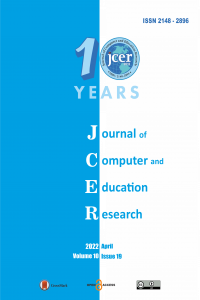Abstract
Bu çalışmanın amacı; fen bilgisi öğretmenlerinin Ters Yüz Öğretim Modeli (TYÖM) hakkındaki görüşlerini belirlemektir. Araştırma, bir durum çalışması olarak desenlemiştir. Verilerin toplanması sürecinde yarı-yapılandırılmış sorulardan oluşan görüşme formu kullanılmıştır. Araştırma, 2020-2021 eğitim-öğretim yılında Güneydoğu Anadolu bölgesinde bulunan bir il merkezindeki sekiz farklı ortaokulda görev yapan, derslerinde dijital araçları kullanan dokuz fen bilgisi öğretmeni ile yürütülmüştür. Verilerin analizinde içerik analizi ve betimsel analiz kullanılmıştır. Araştırmada, ders öncesi etkinliklerin ders başarısını artıracağı, öğrencilerin derse hazırlıklı gelmelerini sağlayacağı, TYÖM’nin etkili ve gerekli olduğu sonucuna ulaşılmıştır. Araştırma sonucunda modelin öğretmenler tarafından bütünüyle bilinmediği ortaya çıkmıştır. Bunun yanında TYÖM’in kullanımında teknolojik alt yapı yetersizliğinin fırsat eşitsizliği oluşturacağına dair bulgular da elde edilmiştir. Modelin uygulanması durumunda ise katılımcılar modelin genel anlamda öğrenmeyi kolaylaştıracağı, öğrencilerin ders başarılarını ve ilgilerini artırabileceğini ifade etmişlerdir.
References
- Akgün, M., & Atıcı, B. (2017). Ters-düz sınıfların öğrencilerin akademik başarısı ve görüşlerine etkisi. Kastamonu Eğitim Dergisi, 25(1), 329-344.
- Albert, M., & Beatty, B. J. (2014). Flipping the classroom applications to curriculum redesign for an introduction to management course: Impact on grades. Journal of Education for Business, 89(8), 419-424.
- Alsancak-Sırakaya, D. (2015). Ters yüz sınıf modelinin akademik başarı, öz-yönetimli öğrenme hazırbulunuşluğu ve motivasyon üzerine etkisi. Yayımlanmamış doktora tezi, Gazi Üniversitesi, Ankara.
- Alsancak-Sırakaya, D. (2017). Oyunlaştırılmış tersyüz sınıf modeline yönelik öğrenci görüşleri. On dokuz Mayıs Üniversitesi Eğitim Fakültesi Dergisi 36(1), 114-132.
- Arslan, H., & Kuzu, A. (2019). EBA ders modülünün ve vsınıf yazılımının ters yüz sınıf modelinde uygulanabilirliğine yönelik öğretmen görüşleri. Bolu Abant İzzet Baysal Üniversitesi Eğitim Fakültesi Dergisi, 19(1), 20-36.
- Aydın, B., & Demirer, V. (2017). Ters yüz sınıf modeli çerçevesinde gerçekleştirilmiş çalışmalara bir bakış: içerik analizi. Eğitim Teknolojisi Kuram ve Uygulama, 7(1), 57-82.
- Benjamin, C. M. (2019). Effects of flipped lessons on academic performance and student involvement in an anatomy and physiology course. Doctoral dissertation, Delta State University. Proquest.
- Bergmann, J., & Sams, A. (2012). Flip your classroom: Reach every student in everyclass everyday. Washington, DC: Internal Society for Technology in Education.
- Bergmann, J., & Sams, A. (2014). Flipped learning: Maximizing face time. The Association for Talent Development, 68(2), 28-31.
- Bishop, J. L., & Verleger, M. A. (2013, Haziran). The flipped classroom: A survey of the research. 120th ASEE Annual Conference& Exposition, Atlanta, GA.
- Bolat, Y. (2016). Ters yüz edilmiş sınıflar ve eğitim bilişim ağı (EBA). Journal of Human Sciences, 13(2), 3373-3388.
- Boyraz, S. (2014). İngilizce öğretiminde tersine eğitim uygulamasının değerlendirilmesi. Yayımlanmamış yüksek lisans tezi, Afyon Kocatepe Üniversitesi, Afyon.
Abstract
The aim of this study is to determine the views of science teachers’ about the Flipped Learning Model (FLM). The research has been designed as a case study. During the data collection process, a semi-structured interview form was used. The research was conducted with nine Science teachers who work in eight different secondary schools in a city center in the Southeastern Anatolia region in the 2020-2021 academic year and use digital tools in their lessons. Content analysis and descriptive analysis were used in the analysis of the data. In the study, it was concluded that pre-lesson activities would increase the success of the lesson, make students come prepared for the lesson, and that the FLM was effective and necessary. In addition, as a result of the research, it was revealed that the model was not fully known by the teachers. As well as, it has been found that the lack of technological infrastructure in the use of the FLM will create inequality of opportunity. If the model was applied, the participants stated that the model would facilitate learning in general and increase students' course success and interest.
References
- Akgün, M., & Atıcı, B. (2017). Ters-düz sınıfların öğrencilerin akademik başarısı ve görüşlerine etkisi. Kastamonu Eğitim Dergisi, 25(1), 329-344.
- Albert, M., & Beatty, B. J. (2014). Flipping the classroom applications to curriculum redesign for an introduction to management course: Impact on grades. Journal of Education for Business, 89(8), 419-424.
- Alsancak-Sırakaya, D. (2015). Ters yüz sınıf modelinin akademik başarı, öz-yönetimli öğrenme hazırbulunuşluğu ve motivasyon üzerine etkisi. Yayımlanmamış doktora tezi, Gazi Üniversitesi, Ankara.
- Alsancak-Sırakaya, D. (2017). Oyunlaştırılmış tersyüz sınıf modeline yönelik öğrenci görüşleri. On dokuz Mayıs Üniversitesi Eğitim Fakültesi Dergisi 36(1), 114-132.
- Arslan, H., & Kuzu, A. (2019). EBA ders modülünün ve vsınıf yazılımının ters yüz sınıf modelinde uygulanabilirliğine yönelik öğretmen görüşleri. Bolu Abant İzzet Baysal Üniversitesi Eğitim Fakültesi Dergisi, 19(1), 20-36.
- Aydın, B., & Demirer, V. (2017). Ters yüz sınıf modeli çerçevesinde gerçekleştirilmiş çalışmalara bir bakış: içerik analizi. Eğitim Teknolojisi Kuram ve Uygulama, 7(1), 57-82.
- Benjamin, C. M. (2019). Effects of flipped lessons on academic performance and student involvement in an anatomy and physiology course. Doctoral dissertation, Delta State University. Proquest.
- Bergmann, J., & Sams, A. (2012). Flip your classroom: Reach every student in everyclass everyday. Washington, DC: Internal Society for Technology in Education.
- Bergmann, J., & Sams, A. (2014). Flipped learning: Maximizing face time. The Association for Talent Development, 68(2), 28-31.
- Bishop, J. L., & Verleger, M. A. (2013, Haziran). The flipped classroom: A survey of the research. 120th ASEE Annual Conference& Exposition, Atlanta, GA.
- Bolat, Y. (2016). Ters yüz edilmiş sınıflar ve eğitim bilişim ağı (EBA). Journal of Human Sciences, 13(2), 3373-3388.
- Boyraz, S. (2014). İngilizce öğretiminde tersine eğitim uygulamasının değerlendirilmesi. Yayımlanmamış yüksek lisans tezi, Afyon Kocatepe Üniversitesi, Afyon.
Details
| Primary Language | Turkish |
|---|---|
| Subjects | Other Fields of Education |
| Journal Section | Research Article |
| Authors | |
| Early Pub Date | April 19, 2022 |
| Publication Date | April 23, 2022 |
| Submission Date | November 1, 2021 |
| Acceptance Date | January 17, 2022 |
| Published in Issue | Year 2022 Volume: 10 Issue: 19 |



